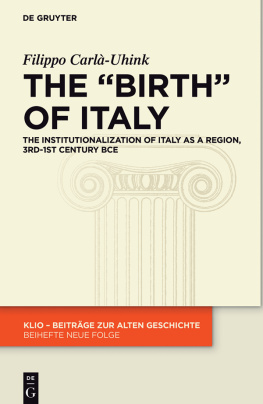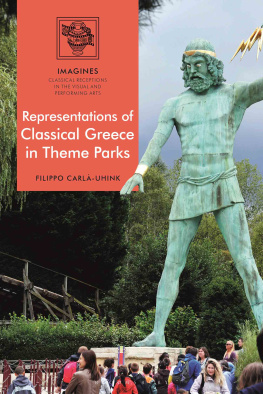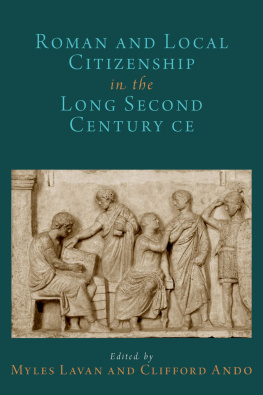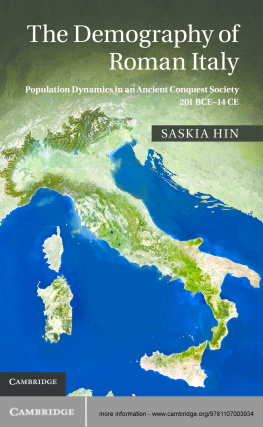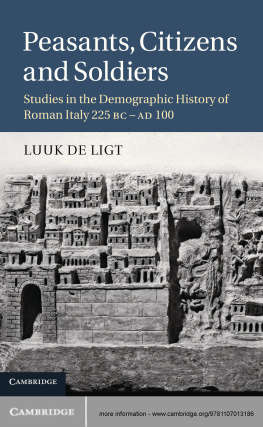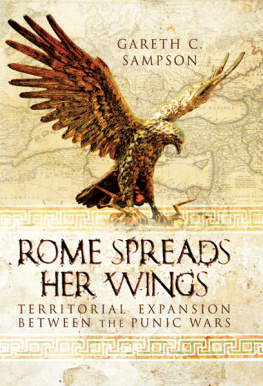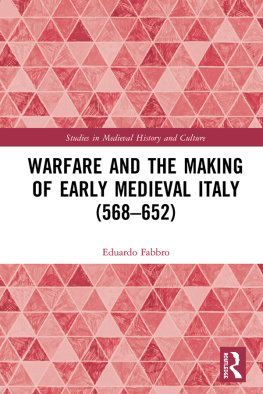Contents
Guide

Filippo Carl-Uhink
The Birth of Italy
KLIO
Beitrge zur Alten Geschichte

Beihefte. Neue Folge
Herausgegeben von
Hartwin Brandt und Martin Jehne
unter Mitarbeit von
Manfred Clauss, Peter Funke
und Hans-Joachim Gehrke
Band 28

ISBN 978-3-11-054287-5
e-ISBN (PDF) 978-3-11-054478-7
e-ISBN (EPUB) 978-3-11-054404-6
ISSN 1438-7689
Library of Congress Cataloging-in-Publication Data
A CIP catalog record for this book has been applied for at the Library of Congress.
Bibliografische Information der Deutschen Nationalbibliothek
Die Deutsche Nationalbibliothek verzeichnet diese Publikation in der Deutschen Nationalbibliografie; detaillierte bibliografische Daten sind im Internet ber http://dnb.dnb.de abrufbar.
2017 Walter de Gruyter GmbH, Berlin/Boston
www.degruyter.com
Acknowledgments
This book was a long time in the making, and has profited from the suggestions, help, support and patience of many people. I started working on the topic, with a very different idea in mind of how the outcome would have looked like, in 2008 at the Ruprecht-Karls-Universitt Heidelberg, where I was able to participate in the activities of the WIN-Kolleg Raumordnung: Norm und Recht in historischen Kulturen Europas und Asiens, funded by the Heidelberger Akademie der Wissenschaften. The meetings and discussions in the group, and in the research seminars of the Seminar fr Alte Geschichte und Epigraphik, were of fundamental importance in shaping my method and better focusing my research questions in this sense particular thanks go to Irene Berti, Markus Hilgert, Martijn Icks, Sebastian Schmidt-Hofner, Kai Trampedach, Johannes Wienand, Christian Witschel. From 2010 I was able to continue working on this project with very substantial financial help from the German Research Foundation (DFG) which, as I had in the meantime moved to the Johannes Gutenberg-Universitt Mainz as Assistant Professor for Cultural History of Antiquity, allowed me to fund a PhD fellowship for Alejandro Daz Fernndez, who there completed his thesis on provincial administration in the Roman Republic, which is in many ways a pendant to this book. Thanks to the DFG we could also organize in Mainz a workshop on Space-Describing and Space-Structuring Concepts in the Ancient World, which took place on the 14 th and 15 th March 2013, and which was of the greatest help in discussing, in a friendly and informal environment, many of the issues that are central to this work. In Mainz I had in general the possibility to work for four years continuously exchanging opinions, doubts and problems with many colleagues and some friends from the most diverse fields. It is impossible to thank here each person who contributed, directly or indirectly, with some random reference to regionalism studies or by reading and commenting on my pages, but I want to mention Fuad Alidoust, Jeorjios Beyer, Anja Busch, Lucia Cecchet, Marion Gindhart, Marietta Horster, Christine Kleinjung, Christine Walde, Franziska Weise. While I am thankful to all of them and many more, three true friends and amazing colleagues need to stand out above all other people from my time in Mainz: Florian Freitag, Jrg Rogge and Christian Rollinger, without whom this book would be very different, and my life would be much more boring and miserable. I finally completed the book at the University of Exeter, where I have taught since 2014, in an extremely stimulating context, in which I have had the luck to discuss my material with a great expert on the topic, Elena Isayev, in whom I found constant, wonderful scholarly support and a dear friend. Together with Lena, many friends and colleagues made my life in Exeter much nicer and easier while I was under the stress of finishing this book, and either directly helped me to improve it, or took good care of me and thus made it indirectly possible: Paola Bassino, Samuel Beckelhymer, Barbara Borg, Nicol DAlconzo, Gabriele Galluzzo, Sharon Marshall, Sebastian Matzner, Erica Rowan, Bobby Xinyue, and the best of all possible housemates, Christopher Farrell. Finally, the book was submitted as Habilitationsschrift at the Technische Universitt Dresden, and profited immensely from the reviews, criticisms and impulses of its referees, Domitilla Campanile, Martin Jehne and Dennis Pausch, to take its final shape. To Martin Jehne I am indebted in many different ways, and it would be impossible to express my gratitude within these few lines. Nonetheless, I want to at least explicitly thank him and Hartwin Brandt who, as editors of the Klio Beihefte , allowed the publication of this monograph in such a prestigious series. Over the years, other friends and colleagues read partial drafts or discussed with me the contents of this book. I would like to thank in particular Marta Garca Morcillo, Fabio Guidetti, Federica Pezzoli, Francisco Pina Polo. Confirming once again that time and life move in circles, the final manuscript receives its last touches as I am back in Heidelberg, at the University of Education, where I teach since April 2017. Linguistic revisions were undertaken, at different moments, by Sophie Jay, Andy Redwood and Amanda Sharp: to them goes all my gratitude for having coped with my Italo-Germano-English without developing murderous desires. Carina Spohn was of significant help with the final revisions, and I am very thankful for her eagle eyes in spotting typos and mistakes. All the people mentioned have been of greatest help, but they of course do not share any responsibility for what is written in the following pages. As is necessarily the case with a book that takes nine years to see the light, it accompanied me through the most diverse phases of my life, through good and bad moments, through different countries and cities, remaining a fixed point in shifting desires, wishes, needs, joys and pains. As such an endeavor discussing the historical past and representing a consistent part of my personal past, it is dedicated to Christian, the Eternity; and Henri, the Future.
Introduction
The Unification of Italy: A Topic and Its History
On March 17, 2011, Italians celebrated the 150 th anniversary of the foundation of the united State of Italy, which was born as a result of the upheaval of the Risorgimento movement after the Second Independence (or Franco-Austrian) War and the Expedition of the Mille led by Garibaldi. The celebration, attributed a central political relevance by the main institutional organs of the country, offered a moment of reflection upon a nation that has, even as perceived by its inhabitants, often been considered lacking in self-consciousness and common identity.
Once again, as in the 19 th century, the problem of Italian identity was center stage. Once again, the resulting discussion was conducted with reference to ancient times and to the Roman Republic as the period when Italy had been united for the first time and a form of Italian common identity was widely perceived to have been developed.
The enormous success of this model of interpretation, which described the gradual and linear process of unification between the 3 rd and the 1 st centuries BCE in a teleological way, for example, the Making of Roman Italy is still represented as a progress narrative in Salmons influential monograph published in 1982.

